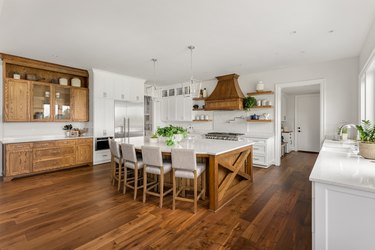
You've heard of Peter Piper picking a peck of pickled peppers, but you may not have heard of pickled cabinets. Pickled cabinets, also referred to as whitewashed or the process of staining wood white, are light wood cabinets with a touch of white paint over them that still allow the grain to be seen.
Historically, pickled woods were not painted white, rather covered with a thin layer of caustic lime and salt to prevent insects from damaging the wood according to The Washington Post. Pickled kitchen cabinet refinishing can be an inexpensive way to update your cabinets with a classic look. Pickling is normally done on light woods with an open grain, especial maple, ash and oak.
Video of the Day
Video of the Day
Refresh Pickled Wood Cabinets
Refresh pickled wood cabinets by doing a deep clean on your existing cabinets. Begin by cleaning near the handles, since this gets the most use and grime is often left behind by our hands. The Washington Post suggests creating a homemade cleaning solution that consists of 4 parts lukewarm water to 1 part white vinegar. You can add more vinegar if you have more substantial stains and need more power to remove them. Wipe th0roughly. Once you are done, wipe once more with just water to remove any vinegar residue.
Test a Portion of Cabinet
Before taking on the entirety of your kitchen cabinets, do a test first to see how the results come out. Pick a door that is not as visible or in a corner as the test subject. Remove the door as well as any hardware and handles. Gently sand the door with the grain. It will most likely be a vertical grain. Wear gloves and a mask so you do not breathe in any dust. Wipe away any dust created from sanding.
Using Primer for Pickled Cabinets
There are a few types of paint and techniques you can use to create the pickled effect. Use leftover primer to create this effect. You want to thin and water down the primer to create a white translucent color. To achieve this, mix 1 part white latex primer-sealer with 3 parts water.
Use a 4-inch brush to paint on the primer in smaller patches. Then use a clean rag to rub the primer in, this time against the grain. Next, use a fresh dry cloth to wipe with the grain to remove excess primer that has pooled in the grain. The goal is to highlight the grain but not paint it in. Focus on one small patch at a time so that the primer doesn't dry before you have a chance to wipe it with the rag. Allow the primer to dry overnight.
Using Paint for Pickled Cabinets
You can also use paint to get the job done. Select your ideal shade of white and water it down by mixing 2 parts paint to 1 part water. You can also buy a pre-made pickling product. The Washington Post recommends Minwax White Wash Pickling Stain.
Put on gloves and apply the paint with a rag. Soak the rag in the paint mixture and rub directly on the cabinet with the grain. Allow the paint to dry. Apply a second coat if the desired color was not achieved with the first coat.
Finish With A Clear Coat
A polyurethane clear coat works great to finish and seal the job. Stir the polyurethane clear coat, but avoid shaking. Pour it into a lined paint cup for easy application. A 2 1/2-inch paintbrush works best. Apply one coat and let it dry for 24 hours.
Use a fine grit sanding sponge to sand gently. Wipe off any dust with a dry cloth. Apply a second coat of polyurethane and allow it to dry for 24 hours.
If you are refinishing pickled oak cabinets and the test cabinet door does not come out looking great, then you can stain it a darker color or choose a paint color to match your kitchen, including painting it shades of white.